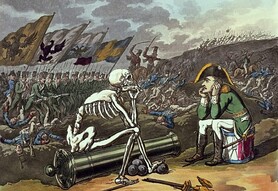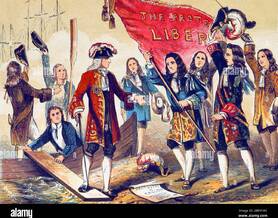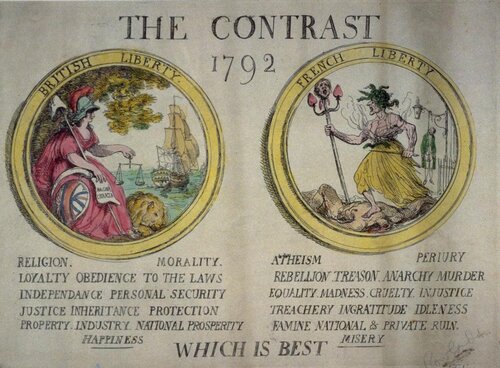-
Par gary johns le 19 Novembre 2022 à 18:49
Was Napoleon a hero or a villain ?
A) Listen to the audio about the events in Jaffa, Egypt in 1799 and explain the painting and the caricature above
B) Click on the link here to read the text. Group A will find arguments for Napoleon being a "hero", and Group B will find arguments for him being a "villain".
-
Par gary johns le 19 Novembre 2022 à 18:05
London (AFP) - Two hundred years after the Battle of Waterloo, Napoleon is still under attack in Britain, where the image persists of a military genius consumed by a fanaticism comparable with Hitler or Stalin.
The emperor of French revolutionaries and regicides continues to strike fear in his neighbours across the Channel, long after his death on the South Atlantic island of St Helena, according to British historian and author Andrew Roberts.
"Mothers used to calm their children with the threat that if you don't watch out, Boney will get you," he told AFP. "There were still children in the 1950s being scared by this particular threat."
Indeed, the title of his latest 900-page biography -- "Napoleon, the Great" -- raised more than the odd eyebrow. Firstly, most Britons would argue that "the Great" was not a fitting epitaph for "little Boney", who is still ridiculed for his small size and lust for war.
"He was also very unlucky that he came to power at the same time as the greatest political caricaturists that the British ever created -- James Gillray and Thomas Rowlandson," said Roberts."They always made him, somehow, to be small like a dwarf but also completely bloodthirsty."


Their drawings depicting "the Lilliputian", "the Corsican plague" and "Beelzebub" recently went on display at an exhibition in London's British Museum.
"I don't suppose anybody in history had been vilified and ridiculed in the way that Napoleon was vilified and ridiculed ever before," said Tim Clayton, a Napoleon expert.
"Because you were frightened of him, you had to belittle him, make him seem not so frightening," added Sheila O'Connell, curator of the exhibition.
"Unfortunately, the British do have a very old-fashioned view of Napoleon, one that was created by the propaganda of the Napoleonic wars," said Roberts.
Since then, the conservative image of Napoleon as "a monster and an evil dictator" has stuck, with the notable exception of great wartime leader Winston Churchill, who described him as "the greatest action man since Julius Caesar".
"He was a conqueror," added Roberts. "Of course he was ruthless. However, all of these things must be seen in the context of a total war, one that lasted 22 years."
"To blame him... for all the wars that took place and killed so many people in Europe, about six million people, I think is totally unfair."
Faced with colleagues such as historian Adam Zamoyski, for whom Napoleon was "megalomaniac, incompetent and a usurper", Roberts argued that his hero was as much the victim of aggression as the perpetrator. After all, Roberts added, The British, Austrians and Prussians launched the first war against revolutionary France in 1792, when Napoleon "was still a second lieutenant of artillery".
However, he could be blamed for "the appallingly opportunist attack in the peninsula against Spain and Portugal in 1807 and 1808 and, of course, the invasion of Russia."
The debate over whether he was a tyrant or hero has provided fodder for thousands of books, cluttering the shelves of British libraries and online shopping sites. With so much detailed analysis in the public domain, historian Roberts is perplexed that Napoleon can still be compared to Saddam Hussein and Moamer Kadhafi or Adolf Hitler and Joseph Stalin, as in a recent BBC documentary.
-
Par gary johns le 11 Novembre 2022 à 10:32
A) Speak about these paintings. Say what you can see and try to guess what is happening.
B) GROUP A : Find out more about the first painting and the event it depicts. Listen to the audio here :
Télécharger « Audio : a famous painting »
C) GROUP B : Find out more about the second painting and the event it depicts. Watch the video here :
-
Par gary johns le 27 Septembre 2022 à 15:04
A) Click on the link to watch the video and answer the questions of part A on the worksheet "The Glorious Revolution"
Télécharger « The Glorious Revolution 3 minute history »
B) Read the text on the "Bill of Rights" and answer the questions of part B on the worksheet
What’s in the Bill of Rights?
The English Bill of Rights includes the following items:
- A list of King James’s misdeeds
- 13 articles that outlined specific freedoms
- Confirmation that William and Mary were rightful successors to the throne of England
In general, the Bill of Rights limited the power of the monarchy, elevated the status of Parliament and outlined specific rights of individuals.
Some of the key liberties and concepts laid out in the articles include:
- Freedom to elect members of Parliament, without the king or queen’s interference
- Freedom of speech in Parliament
- Freedom from royal interference with the law
- Freedom to petition the king
- Freedom to bear arms for self-defense
- Freedom from cruel and unusual punishment and excessive bail
- Freedom from taxation by royal prerogative, without the agreement of Parliament
- Freedom of fines and forfeitures without a trial
- Freedom from armies being raised during peacetimes
Other important provisions were that Roman Catholics couldn’t be king or queen, Parliament should be summoned frequently and the succession of the throne would be passed to Mary’s sister, Princess Anne of Denmark and her heirs (than to any heirs of William by a later marriage).
Constitutional MonarchyThe English Bill of Rights created a constitutional monarchy in England, meaning the king or queen acts as head of state but his or her powers are limited by law.
Under this system, the monarchy couldn’t rule without the consent of Parliament, and the people were given individual rights. In the modern-day British constitutional monarchy, the king or queen plays a largely ceremonial role.
-
Par gary johns le 25 Août 2022 à 11:22
A) Speak about this document
B) Read the article
Télécharger « History Hit document What did Britain think of the French Revolution »
 Suivre le flux RSS des articles de cette rubrique
Suivre le flux RSS des articles de cette rubrique
Collège Jacques Prévert - Les Arcs sur Argens -







